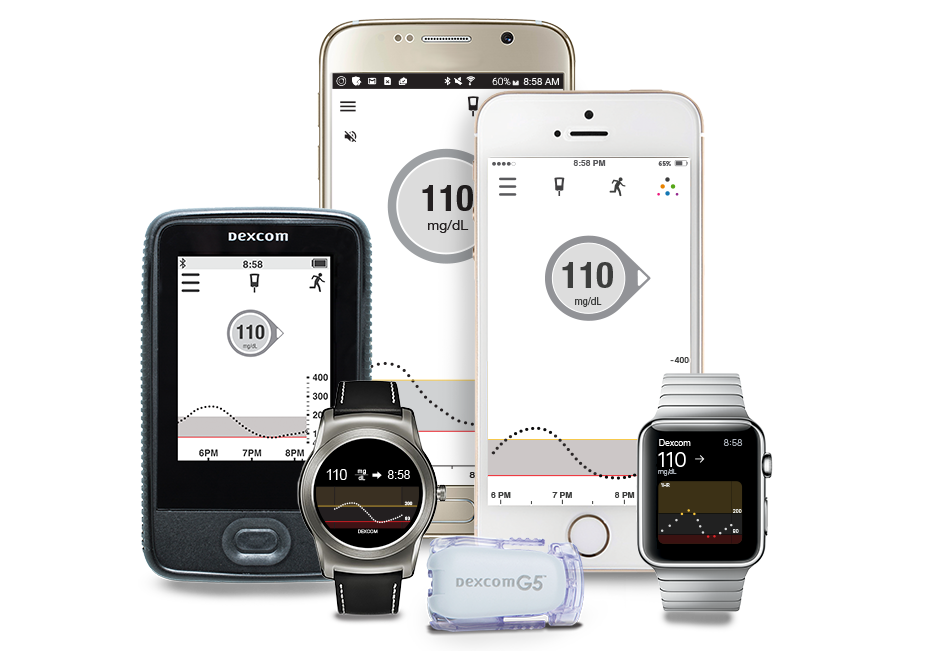After thirty years of poking my finger ten to fifteen times a day, the most life-changing device I now use to monitor and manage my type 1 diabetes is a Continuous Glucose Monitor (CGM). In my opinion, it is the most valuable tool available for achieving good blood sugar levels and a healthy A1c.
I use one made by Dexcom as I find it to be the most accurate on the market. My Dex, as I like to call it, allows me to know exactly what my readings are at all times, with just the push of a button. I love having the ability to watch what my blood sugars are doing at every moment throughout the day and make needed adjustments on the spot. This feature is incredibly valuable in that it allows me to avoid having high blood sugars go unnoticed for hours at a time, which occurred for over thirty years of my life prior to using a CGM.
A CGM instantly shows the effects of food, exercise, sleep and stress on blood sugar. It helps me control the highs and lows, the spikes and dips. I set alerts to notify me when my glucose level goes too high or too low so I can take action right away. It will wake me up if my blood sugar goes high or low, allowing me to now go to sleep without anxiety. When I exercise, I just keep it in my pocket. I love not having to stop what I’m doing to test since I can feel confident I’m in range — as long as it’s not vibrating.
It’s unfortunate how many people have never heard of this technology because it is so life-changing for people with diabetes.
How a CGM works:
The CGM consists of a couple different parts.
- The Sensor. A tiny filament, called a sensor, is placed below the skin’s surface. It is thinner than a needle and about a half inch long. It is inserted with a needle, which is then withdrawn. The sensor can stay in place for a week or longer (depending on which type of CGM you have). It detects glucose in the extracellular fluid and communicates with the transmitter.
- The Transmitter. The transmitter attaches to the sensor. The two combined are usually only about one to two inches long (depending on type being used) and are generally placed on the abdomen. Other sites such as the arms, back and leg can also be used. I prefer to wear mine on my tricep or on the outer side of my low back, right above my pant line. The transmitter sends data to the receiver.
- The Data Receiver. The receiver can be a stand-alone receiver, or the data can be sent to an insulin pump, smart-watch or smart-phone. Whichever type of receiver is being used, the blood sugar level is displayed on a graph that shows the present blood sugar reading, as well as over the past 24 hours.
The sensors contain an enzyme called glucose oxidase that reacts with glucose to produce hydrogen peroxide. Another enzyme called catalase breaks down the peroxide into oxygen and water, and the oxygen levels (proportional to the glucose concentration) are detected. This explains why it can be inaccurate when the sensor is compressed, for example if lying on it during sleep. If the oxygen levels decrease, the system can mistake this for a drop in glucose concentration.
Since the sensor is not directly in the bloodstream, there is usually a 10–20 minute delay in the reading. So, if the blood sugar is going low or high, you might not be alerted for up to 20 minutes. There can also be a long delay in its accuracy after treating a low, which can lead to the mistake of over-treating, since it’s still reading you as low when you are actually no longer. Be mindful of this as it’s unfortunately very easy to keep eating sugar when it’s continuing to show a low number when you’re actually not, and then of course soon end up with a high.
Another common reason for inaccuracies is caused by not following the proper calibration techniques required by the particular device. It is best to avoid calibrating the CGM when the blood sugar is on a steep rise or fall. Aim to calibrate when the blood sugar is somewhat steady. Be sure to read the accompanying manual on proper techniques needed by your particular device.
Type 2 and Pre-Diabetes
If you are not on insulin, although a CGM can be a beneficial learning tool to gauge your blood sugar reaction to foods, exercise, stress, etc. — it is usually only covered for people who take insulin. Also, they are costly but fortunately new, lower cost options are becoming available, such as the Freestyle Libre.
How to Check for Coverage
The best way to see if you qualify for coverage is to contact a patient sales representative from the device company you are interested in using. They should do all the heavy lifting of contacting your insurance company and tell you what data you may need to collect for approval. The Dexcom is covered by Medicare and Medicaid.
Knowledge is Power
Diabetes takes a lot of work to manage on a daily basis. Any technology that can help ease the burden and give us life-saving information on what is happening with our blood sugars in real time is incredible. To anyone with type 1 diabetes who is looking for better control, my first piece of advice is always: get a continuous glucose monitor.
Want support on how to get an A1c below 6.5%? Dr. Jody offers private calls, online courses, and a monthly education program called The T1D CREW. Learn more here: www.DrJodyND.com.





